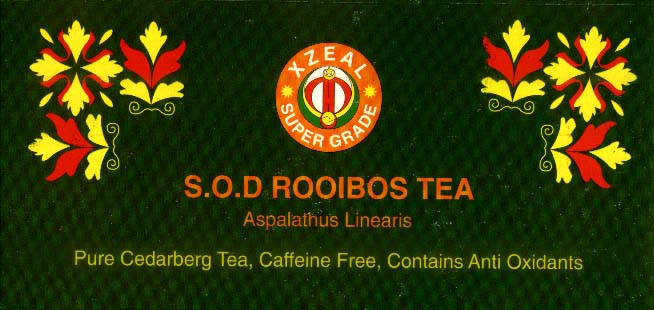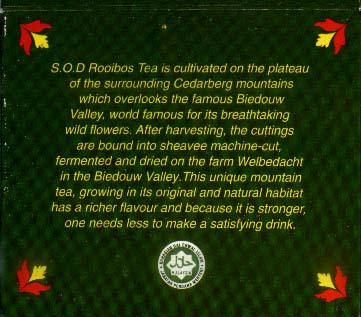:: Muka Utama
:: Pengenalan
:: Apa itu SMS?
:: Soalan Lazim
:: Bussines Kit
:: Hubungi Kami


Roolbos Tea - Some Quick Facts Health I Ingredient Facts
· Beneficial in the treatment of diabetes, high blood pressure, irritability, headaches, stomach cramps, disturbed sleeping patterns, insomnia, nervous tension, mild depression or hypertension, liver diseases, allergies, cataracts, skin irritations and other conditions (especially when applied directly to the affect area), mellitus, atherosclerosis, and colic and feeding problems in infants. The list continues: nausea and vomiting, constipation, stomach ulcers, heartburn.
· Low tannin content. (only 1 to 4 percent)
· Acts as a powerful antioxidant. (only 1 to 4 percent)
· Replenishes iron levels, which is especially helpful to breast-feeding or pregnant women.
· No negative side effects ever reported.
· Fresh from nature, meaning it is 1000/o organic, with no additives, preservatives, or colourants.
· Completely caffeine-free!
· Free from any harmful stimulants.
· Boosts the Immune system.
· Can be mixed with milk, unlike other teas.
· Has a natural hint of sweetness, but also tastes great with honey, lemon, and many others!
· Contains no oxalic acid, allowing those suffering from kidney stones to drink it freely.
· Aids your body's natural schedule, relaxing you at night and stimulating you in the day.
· Delicious flavor!
|
Nutrien |
Function in the body |
|
Iran (Fe) Potassium (K) Copper (Cu) Calcium (Ca) Manganese (Mn) Fluoride (F)
Zinc (Zn)
Magnesium (Mg)
Sodium (Na) |
Essential for transport of oxygen in the blood Necessary for metabolic function Necessary for different metabolic processes Necessary for strong teeth and bones
Necessary for metabolic processes and for bone development Necessary for healthy teeth and bones Necessary for normal growth and development and a healthy skin Necessary for a healthy nervous system and for metabolic processes
Necessary for fluid and acid-base balance |
Roolbos Tea - A History of Delicious Healing
Roolbos Tea has a tasty flavor. It doesn't have any caffeine. It relieves depression. It relieves stress. It even relieves constipation, among a wide variety of other problems ranging from Insomnia to colic. It helps you relax at bedtime but also keeps you refreshed during the day. The list of benefits goes on and on, but this herbal tea doesn't have any negative side effects!
Meet Roolbos Tee.
Roolbos (pronounced my-boss) was first used by natives in South Africa when they mashed the stems and leaves of the roolbos plants with hammers. The natives then left the remains of the roolbos plants to ferment in the sun, and created a fiavorftii drink from that result. That same drink was then discovered and reported in 1772 by botanist Carl liumberg. Unfortunately, at the time, the wide variety of the healing powers of the plant were left unknown, and it simply became popular because of its mouth-watering taste.
It HeaIs!
In April 1986, almost 200 years after Humberg reported the drink, a South African [-mother named Annique Theron was pacing back and forth, worrying about her I allergic infant that had been struggling with colic attacks. In her stress, she had I accidentally added Roolbos Tea to her baby85 milk. Soon, the fburteen-month streak of constant crying and vomiting had stopped, and the baby slept peacefully for over three hours. Obviously, this was an exciting discovery, and after failing to find any documented evidence of these healing properties, Annique took it upon herself to perform her own research on the properties of Roolbos. Soon, eighteen babies with similar problems were given the Roolbos Tea treatment, and the mothers quickly sent In news that the babies were doing better. Annlque~s findings were quickly published, and to date, those findings have helped thousands upon thousands of allergic people of all ages to overcome their symptoms with Roolbos.
Rooibos... that name...
Roolbos Tea, which Is sometimes misspelled as Rooibus Tea, is also known as Red Bush Tea or just Red Tea, because the plant leaves turn a reddish-brown at a certain point as the roolbos plant ripens. The Japanese chose to give It another name based on Its anti-aging properties, namely Long Life Tea. Japan has done extensive research on Its healing properties, and imports, researches, and consumes over 310 tons of the tea annually. Their research alone has led to the discovery of many more benefits of Roolbos Tea, or Long Life Tea.